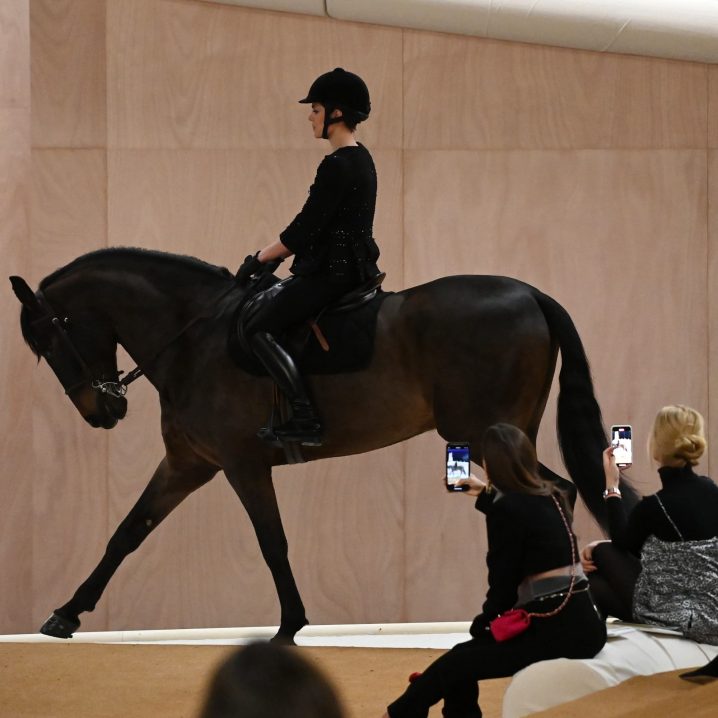
- POPSUGAR Australia
- Fashion
- Fashion Is Trying to Bring Back the Worst Y2K Trend – Using Real Animals as Accessories
Fashion Is Trying to Bring Back the Worst Y2K Trend – Using Real Animals as Accessories

It all started at Chanel‘s spring/summer 2022 haute couture show in Jan. Grace Kelly’s granddaughter Charlotte Casiraghi opened the catwalk by riding on horseback, but critics viewed the spectacle in bad taste. While also fuelling whispers that the brand is trying to compete with equestrian-focused Hermès, fans were quick to call out the ethics of using an animal as a prop – particularly when horses are notoriously skittish. The use of real animals as fashion accessories or luxury items is having an unforgivable comeback. And while Chanel’s choice to put a horse on its runway might have Coco rolling in her grave, designers across London and Milan were also guilty of indulging in the unethical trend.
“Quick fashion! The planets on fire! We need to fix things stat! (Fashion puts a live horse in the runway.) I’m getting more and more tired of these antics when the industry should be reforming its ways.” – Aja Barber, climate activist
Only a week prior to Chanel’s faux pas, Gucci was challenged by animal rights group World Animal Protection for a similar misstep. The Italian fashion brand, known for its theatrics, cast live tigers in its ad campaign to celebrate the Chinese Year of the Tiger. In response, World Animal Protection made it clear that tigers are not fashion accessories, and launched a petition to stop Gucci from exploiting wild animals in ad campaigns. The incident wasn’t isolated to horses and tigers. In the weeks following Chanel’s horse and Gucci’s tigers, brands at London Fashion Week and Milan Fashion Week used cats and dogs as fashion accessories.
At London Fashion Week in Feb., Yuhan Wang cast an actual cat on the catwalk for the designer’s “Venus in Furs” show. The cat was carried by a model like a fashion accessory, to match the colours of the model’s fur coat with the cat’s fur coat. “Women are like cats,” Yuhan Wang told Metal Magazine. “Sometimes we can be very cute but sometimes we can bite.” The feline in question at Wang’s autumn/winter 2022 show was the designer’s own Persian cat Misty. And despite Misty being under the care of the designer herself, and Wang using faux fur throughout the collection, was it really necessary to bring the cat into the mix? At Milan Fashion Week, VTMNTS (previously Vetements) sent a puppy down the catwalk as an accessory to a model’s head-to-toe leather outfit. It was a tone-deaf pairing to use a live puppy as an accessory to an outfit that is made out of a dead cow’s skin, considering the ethics of using animal skins and furs in fashion. When a live animal is the most interesting thing at your fashion show, “maybe it’s time to reevaluate the collection,” commented Instagram account Defunct Fashion.
The “live animals as accessories” trend is latching on to the Y2K revival. In 2001, Britney Spears wore a massive snake like it was a feather boa during her “I’m a Slave 4 U” performance at the MTV VMAs, which went down as one of the most memorable pop culture moments of the decade. It wasn’t until Netflix’s “Tiger King” debuted in March 2020 that we were made aware of the ethics behind the snake, which was borrowed from Myrtle Beach Safari’s problematic owner Doc Antle. In the same year as Britney Spears’s snake performance, “Legally Blonde” premiered and the fashion world was fixated with Elle Woods’s pet Chihuahua. The character of Bruiser Woods became so stylish that it inspired Paris Hilton to get her own fashion dog – Tinkerbell the Chihuahua. The little dog was positioned as a fashion accessory by Hilton and accompanied her to events for a solid three years – wearing matching outfits to the socialite, and often travelling in her handbag. It wasn’t until Tinkerbell died in 2015 that “handbag dogs” began to fall out of fashion, which left hundreds of small dogs abandoned at animal shelters.
More recently during the pandemic, many people impulsively got a “lockdown puppy” out of loneliness or boredom. When government restrictions to stay at home ended, animal welfare charities had to brace for an influx of abandoned pups and dogs. “We have long feared that the combination of a surge in spur-of-the-moment pet ownership during the pandemic, the change in people’s circumstances as some normality returned, and the economic impacts of the pandemic could be a perfect storm for abandonment,” RSPCA inspector Clive Hopwood told The Guardian. Using an animal as a luxury item is basically saying that like a handbag or a new dress, an animal is just as disposable. And while it might seem harmless for a model to cradle a cat or a dog while walking down the runway, these beloved pets are still being exploited by the fashion industry for their skins and furs to make clothing. Animals are not accessories. And if the fashion industry needs to use their cuteness, their danger, or their obedience to sell a collection then maybe its time to rethink the direction.

